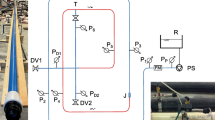Abstract
In this paper, a technique for simulation of the space-time flow parameters in branched channels under transient boundary conditions is presented. The technique is based on the solution of one-dimensional nonstationary equations of gas dynamics. We suggest the conditions of channel junction with regard for distinctive features of a fluid flow in the adjacent region and compare the data on the flow simulation in the channel with a lateral branch by using one-dimensional and three-dimensional models. Comparing the data obtained with the experimental results, we show that the technique being suggested adequately simulates the real processes in the branched channels.
Similar content being viewed by others
References
Davletshin, I.A. and Mikheev, N.I., Separation Zone in Fluctuating Flow Past an Obstacle in a Channel, Izv. RAN. Mekhanika Zhidkosti i Gaza, 2010, vol. 45, no. 5, pp. 86–91 [Fluid Dynamics (Engl.Transl.), vol. 45, no. 5, pp. 753–758].
Davletshin, I.A. and Mikheev, N.I., and Gol’tsman, A.E., Hydraulic Resistance of Smooth Pipes at Pulsating Gas Flow Regimes, Trudy Akademenergo, 2011, no. 1, pp. 22–30.
Valueva, E.P., Fluctuating Turbulent Flow in Tubes. Part 2. Compressible Flows, Vestnik Mosk. Energ. Inst., 2007, no. 2, pp. 16–22
Mikheev, N.I., Molochnikov, N.I., Davletshin, I.A., and Dushina, O.A., Simulation of Pulsating Channel Flows, Izv. Vuz. Av. Tekhnika, 2009, vol. 52, no. 1, pp. 50–52 [Russian Aeronautics (Engl.Transl.), vol. 52, no. 1, pp. 77–82].
Warren, M.D. Open-End Outflow Boundary Approximations for the Solution of the Equations of Unsteady One-Dimensional Gas Flow by the Lax-Wendroff Method, International Journal of Heat and Fluid Flow, 1984, vol. 5, no. 1, pp. 43–50.
Shashkin, V.Yu., Mathematical Simulation of Working Medium in Complex Multi-Channel Systems, Vestnik YuUrGU. Energetika, 2009, no. 34, pp. 41–44.
Enikeev, R.D. and Chernousov, A.A., Simulation and Experimental Studies of Unsteady-State Gas Flows in the Branched Pipelines, Vestnik UGATU, 2007, Vol. 9, no. 6 (24), pp. 98–106.
Idel’chik, I.E., Spravochnik po gidravlicheskim soprotivleniyam (Handbook on Hydraulic Resistance), Moscow: Mashinostroenie, 1992.
Alemasov, V.E., Dregalin, A.F., and Tishin, A.P., Teoriya raketnykh dvigatelei (Theory of Rocket Engines), Moscow: Mashinostroenie, 1989.
Schlichting, H., Boundary Layer Theory, N.Y.: McGraw Hill Book Company, 1968.
Roache, P.J., Computational Fluid Dynamics, Albuquerque: Hermosa Publs, 1976.
Author information
Authors and Affiliations
Additional information
Original Russian Text © D.I. Zaripov, N.I. Mikheev, N.S. Dushin, 2013, published in Izvestiya VUZ. Aviatsionnaya Tekhnika, 2013, No. 1, pp. 23–27.
About this article
Cite this article
Zaripov, D.I., Mikheev, N.I. & Dushin, N.S. A technique for simulation of a fluid flow in branched channels. Russ. Aeronaut. 56, 30–36 (2013). https://doi.org/10.3103/S1068799813010054
Received:
Published:
Issue Date:
DOI: https://doi.org/10.3103/S1068799813010054




